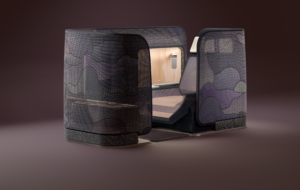

words Marcus Fairs
“Fashion used to be really exciting in Tokyo but now it’s more about design,” says Teruo Kurosaki– the most influential figure in contemporary design in Japan. “It’s really exciting here and full of energy.”
Kurosaki is the founder of Tokyo Designers Block (TDB), the design festival that takes over the streets of Aoyama and Omotesando for five days every October (see pages 63-67). But his influence extends much further than that.
He’s a bit like Terence Conran and Giulio Cappellini rolled into one: a talent-spotter, retailer and manufacturer who has introduced his countrymen to Western contemporary design and helped a string of designers – including Marc Newson, Philippe Starck and Shiro Kuramata – gain international recognition.
He owns the Idée and Sputnik chains of design shops in Tokyo and a string of restaurants. He’s something of a philanthropist, too: he recently opened the Ikejiri Institute of Design – an “incubator” for young Japanese designers – in an abandoned junior school. Another of his initiatives, R-project, rescues disused commercial buildings that have become liabilities due to the collapse of land values in Tokyo and turns them into community assets.
But it’s TDB that has had the most visible influence on his home city: in just five years, it’s established itself as the most hedonistic and talked-about design event in the world. Tokyo does not really have much of a manufacturing base so designers don’t come here to do deals – they come to hang out and have fun. This year, figures including Ron Arad, Tom Dixon and Jasper Morrison made the 12,000-mile round trip.
Kurosaki got the idea, and the name, for TDB after visiting London’s designersblock – the annual show that broke the trade-show mould by presenting the work of streetwise designers in decidedly un-corporate venues such as abandoned warehouses.
“We took the London design scene to Tokyo and into the back streets,” he says. TDB is akin to a street festival, with over 200 mini-events hosted in the bars, restaurants and shops in narrow lanes off the main shopping drags.
“It’s taken people away from the big fashion shops on the main streets into the back streets. All these back-street shops – coffee shops, bookstores, restaurants – are opening. It’s the first time anything like this happened in Tokyo. The whole city has changed in five years.”
Kurosaki believes the event has transformed not just the Aoyama/Omotesando area, but the design culture of the entire city. He says the buzz of TDB has encouraged young designers who work for Japan’s huge corporations to express their individuality more. “Corporate designers are joining us – they are mounting solo shows. They still work for the big companies but they work as independent designers at the weekend and they exhibit at TDB.”
Kurosaki, 54, spent his formative years travelling the world as a hippy with a Jimi Hendrix haircut. When he got to London he set up a business exporting antiques from the Portobello Road to Tokyo, but soon found himself drawn to contemporary design.
Later, in 1984, he was the first person to take Philippe Starck to Tokyo, mounting an exhibition of his work and introducing him to wealthy clients who commissioned a string of outlandish buildings from the French designer during the insane years Kurosaki calls the “bubble time”. He also launched the career of Marc Newson: Kurosaki brought the Australian designer to Tokyo, where he produced many of his best-known pieces for the Idee brand.
Post-bubble, Kurosaki built up his retail empire and, in response to the harsh economic climate, focused on selling affordable lifestyle products to consumers who were disillusioned with the strictures of the conformist salaryman ethos and were increasingly interested in the Western concept of expressing personal identity through possessions. He says his customers are “young, old, rich, poor – there’s no class system in Japan”.
Five years ago, Kurosaki’s magpie eye was once again drawn to London, where streetwise consumers tend to express themselves through creative customisation and recycling rather than the slavish consumption of expensive brands. “In Japan, British street style is quite popular,” he says. “I felt that in Tokyo, people had the money and the interest in design for it to work. It’s not so much about money now but about content.”
Kurosaki clearly enjoys importing subversive ideas. The theme of this year’s TDB was 1968 – the year of youth rebellion and protest – while last year his Idee flagship hosted an exhibition of pornographic mannequins and a deliberately disgusting installation of oozing black polyurethane lava forms by Berlin-based designer Jerszy Seymour.
“I’ve had encounters with lots of Japanese companies,” says Seymour. “There’s so much formality, they all wear black suits. But Kurosaki is a complete nutter.”
“He’s probably the most un-snobbish design visionary around,” he adds. “He’s really into young energy – he doesn’t care about tradition. He’s one of very few people in the world who really understands what design means now and for the future. He’s got balls.”
Seymour credits Kurosaki with creating a design dialogue between Japan and the West. “At the time he started up, design didn’t really exist in Japan,” he says. “They were all sitting on futons. With TDB he’s trying to create a public event, not a trade show.”
But as TDB expands, it is influencing the corporations that Kurosaki has set himself up in opposition to. He says he has spent “several million dollars” on TDB over the past few years but adds that this year, for the first time, Japanese multinationals have pitched in with sponsorship, meaning the 2004 event broke even. “Tokyo is too corporate – we started against that but now the corporations are coming to us. Sony and Canon are sponsoring us,” he chuckles. “They cannot ignore us now.”


















